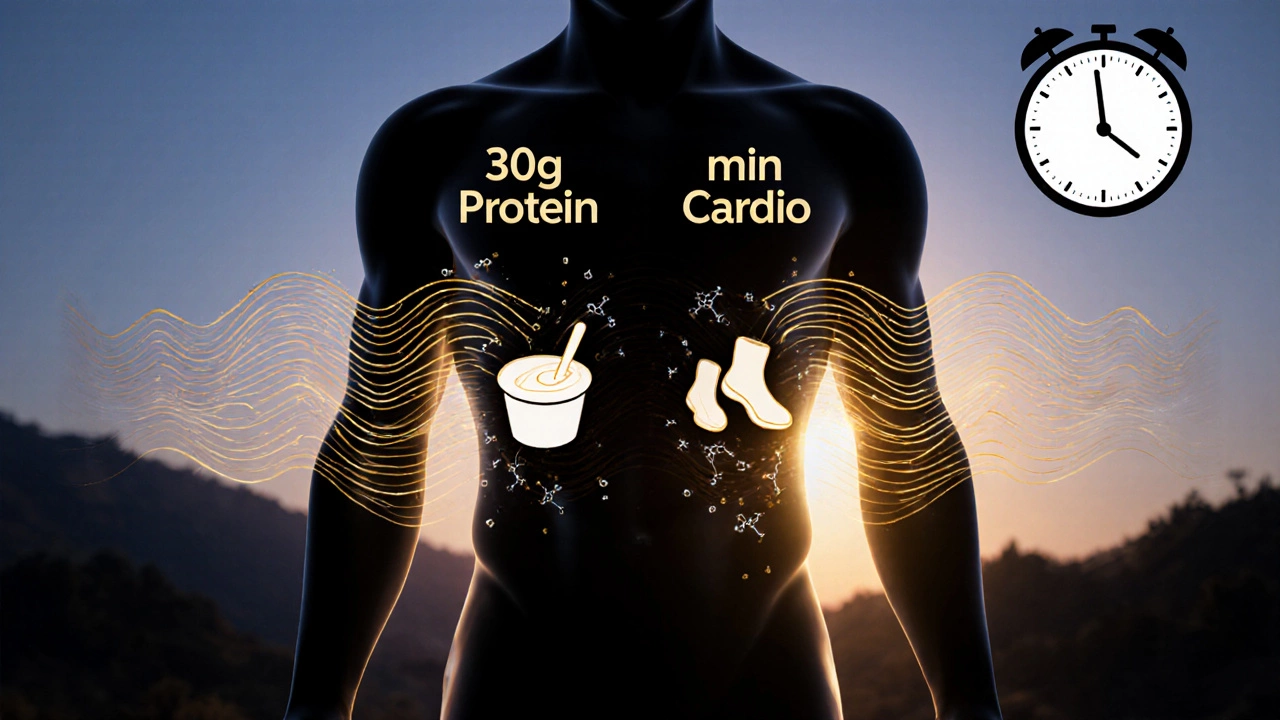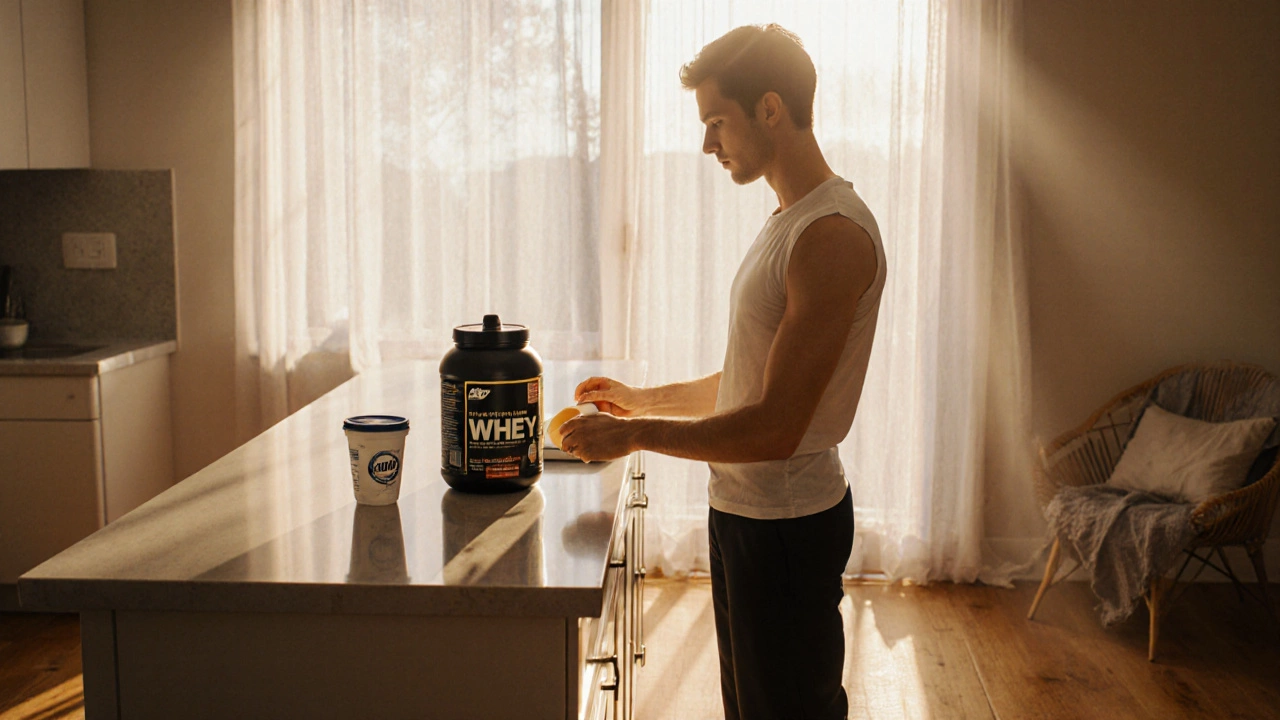30/30/30 Protein Calculator
Get Your 30g Protein Breakfast
Calculate exactly how much of your favorite protein sources you need to hit 30g before 30 minutes of waking. Just select your food and quantity.
Ever tried every diet and still can’t seem to lose stubborn fat? You’re not alone. Many people burn out chasing quick fixes-keto, intermittent fasting, juice cleanses-only to gain it all back. But there’s a simple, science-backed method gaining traction that doesn’t require starving yourself or spending hours in the gym. It’s called the 30/30/30 method for losing fat. And no, it’s not magic. It’s just smart timing.
What Exactly Is the 30/30/30 Method?
The 30/30/30 method is a morning routine designed to kickstart your metabolism and shift your body into fat-burning mode. The name breaks down like this:
- 30 grams of protein within 30 minutes of waking up
- 30 minutes of low-intensity cardio right after
That’s it. No complex tracking. No calorie counting. Just two simple, repeatable actions done first thing in the morning. It’s not a diet. It’s a habit. And habits, when done consistently, change your body over time.
This method was popularized by fitness coach and biohacker Dr. John Berardi, who studied how protein intake and morning movement affect fat oxidation. His research, combined with real-world results from thousands of clients, showed that people who followed this routine lost fat faster-even when they ate the same number of calories as before.
Why Protein First Thing in the Morning?
When you wake up, your body has been fasting for 6-10 hours. Your blood sugar is low. Your muscles are in a catabolic state-meaning they’re breaking down for energy. If you reach for a croissant or a bowl of cereal, you spike insulin, which tells your body to store fat instead of burn it.
But if you eat 30 grams of protein right away, you do three powerful things:
- Stop muscle breakdown
- Boost your metabolism for the rest of the day
- Reduce hunger hormones like ghrelin
Studies from the University of Texas found that people who ate 30 grams of protein at breakfast felt fuller longer and ate 135 fewer calories later in the day. That’s almost a full meal’s worth of calories saved without even trying.
Good sources? Eggs, Greek yogurt, cottage cheese, whey protein shake, lean turkey, or even canned tuna. You don’t need fancy supplements. A single scoop of whey protein powder has about 25 grams. Add two boiled eggs, and you’re there.
Why Low-Intensity Cardio? Not HIIT?
You might think: “Shouldn’t I go hard? Burn more calories?” But here’s the catch-high-intensity workouts like HIIT spike cortisol, the stress hormone. When cortisol is high, your body holds onto belly fat. That’s the last thing you want if your goal is fat loss.
Low-intensity cardio-like walking, cycling, or a slow treadmill stroll-keeps your heart rate between 50-70% of your max. At this level, your body primarily burns fat for fuel, not sugar. And because it’s gentle, you’re more likely to stick with it.
Research from the Journal of Applied Physiology showed that people who did 30 minutes of steady-state cardio in the morning burned 20% more fat throughout the day than those who worked out later. Why? Because morning exercise sets your body’s fat-burning engine in motion and keeps it running longer.
You don’t need a gym. Walk around your neighborhood. Ride a stationary bike while watching the news. Even pacing while on a phone call counts.

How This Works With Your Body’s Natural Rhythm
Your body runs on circadian rhythms. Cortisol peaks in the morning to help you wake up. Insulin sensitivity is highest right after sleep. That means your body is primed to use nutrients efficiently-especially protein and movement.
By eating protein and moving before your day gets busy, you’re aligning with your biology, not fighting it. You’re not forcing your body to do something unnatural. You’re giving it exactly what it needs to start the day in fat-burning mode.
People who follow this method report better energy, fewer cravings, and more consistent weight loss-even without cutting carbs or avoiding dessert. One woman in Sydney, 47, lost 14 pounds in 10 weeks just by doing this. She didn’t change anything else. No diet apps. No meal prep. Just protein and a walk.
What to Avoid When Trying the 30/30/30 Method
This method is simple, but people still mess it up. Here’s what not to do:
- Don’t skip the protein. If you only do the walk, you’ll feel hungry by 10 a.m. and end up snacking on junk.
- Don’t do high-intensity workouts. Save sprints and heavy lifting for later in the day. Morning is for fat oxidation, not muscle breakdown.
- Don’t wait until after coffee. Coffee can delay your hunger signals, but it doesn’t replace protein. Drink your coffee after your 30 grams.
- Don’t expect overnight results. This isn’t a 7-day challenge. It’s a 30-day habit. The magic happens after week three.
Real-Life Examples: Who This Works For
This method isn’t for everyone-but it’s perfect for:
- Busy parents who can’t find time to meal prep
- Office workers stuck at desks all day
- People who hate counting calories
- Those who hit weight loss plateaus
It’s not ideal for:
- Professional athletes training for performance
- People with kidney disease (high protein isn’t safe for them)
- Those who are underweight or have eating disorders
For most people trying to lose fat, though, it’s one of the easiest ways to create a sustainable edge.

How to Start Today
Here’s your simple 5-step plan to begin the 30/30/30 method tomorrow:
- Before you get out of bed, prep your protein: a shake, a container of Greek yogurt, or boiled eggs.
- Drink a glass of water as soon as you wake up.
- Within 30 minutes of waking, eat your 30 grams of protein.
- Put on walking shoes and head outside-or turn on a treadmill, stationary bike, or even just pace around your home for 30 minutes.
- Do this every day for 21 days. No exceptions.
Track how you feel, not just the scale. Many people notice their clothes fitting better, less bloating, and more energy before the pounds drop.
Why This Beats Fad Diets
Fad diets promise fast results but fail long-term because they’re unsustainable. They rely on restriction, willpower, and guilt. The 30/30/30 method doesn’t ask you to give up your favorite foods. It just asks you to start your day right.
It works because it’s easy. It doesn’t require willpower-it requires routine. And routines, once built, run on autopilot.
When you combine protein’s appetite control with morning fat-burning movement, you’re not just losing weight. You’re retraining your body to burn fat naturally. That’s the kind of change that lasts.
Can I do the 30/30/30 method if I’m not a morning person?
Yes, but you’ll need to adjust the timing. The key is doing it before your first calorie-dense meal. If you wake up late and eat breakfast at noon, do your protein and walk right before that meal. The goal is to spike protein and movement before your body shifts into storage mode. It’s not about the clock-it’s about the sequence.
Do I need to do this every single day?
For best results, yes. Consistency is what turns this from a trick into a transformation. Missing one day won’t ruin your progress, but skipping it regularly will stop the momentum. Think of it like brushing your teeth-you don’t do it because it’s fun. You do it because it works over time.
Can I eat carbs after the 30/30/30 routine?
Absolutely. This method isn’t low-carb. You can have oatmeal, fruit, or toast later in the day. The trick is timing. Protein and movement first. Carbs can come after your body has already started burning fat. Your insulin sensitivity is still high in the morning, so your body handles carbs better than if you ate them first thing.
Will this help me lose belly fat specifically?
Yes. Belly fat is often the first to go when you lower insulin and reduce stress hormones. The 30/30/30 method does both. Protein lowers insulin, and low-intensity morning cardio reduces cortisol. Together, they create the ideal environment for targeting stubborn abdominal fat.
Is 30 grams of protein too much for one meal?
No. Research shows that adults need at least 25-30 grams of protein per meal to fully activate muscle protein synthesis. Most people eat less than 15 grams at breakfast. That’s why they stay hungry. 30 grams isn’t excessive-it’s what your body actually needs to function optimally.
What Comes Next?
If you’ve tried everything else and still haven’t seen results, the 30/30/30 method might be the missing piece. It’s not flashy. It doesn’t promise miracles. But it’s one of the few fat-loss strategies backed by real biology-and real people getting results.
Start tomorrow. Eat your protein. Take your walk. Repeat. In 30 days, you might not just look different-you’ll feel different too.
